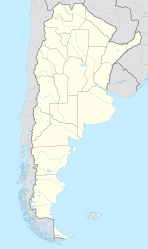Pergamino, Buenos Aires
| Pergamino | |
|---|---|

San Nicolás Street, Pergamino.
|
|
| Pergamino | |
| Coordinates: 33°53′S 60°34′W / 33.883°S 60.567°WCoordinates: 33°53′S 60°34′W / 33.883°S 60.567°W | |
| Country |
|
| Province |
|
| Partido | Pergamino |
| Foundation | 1749 |
| Elevation | 56 m (184 ft) |
| Population (2010 census [INDEC]) | |
| • Total | 104,985 |
| CPA Base | B 2700 |
| Area code(s) | +54 2477 |
| Website | Official website |
Pergamino (Spanish pronunciation: [perɣaˈmino]) is an Argentine city in the Province of Buenos Aires. It has a population of about 104,985 inhabitants as per the 2010 census [INDEC] and is the administrative seat of its county, Pergamino Partido. Its UN/LOCODE is ARPGO.
Long valued for its many springs and fertile land, the area had been home to the Charrúa and Araucanian people when it was first noticed by Spanish colonist around 1620. Becoming a posada along the trade route between colonial Buenos Aires and Córdoba, the settlement was given its name on 3 January 1626, for the parchment paper (document lost by a group of Spaniards)found there and conforming to an Araucanian term meaning "red soil."
The settlement's first businesses were established in 1700 and in 1749, recurrent attacks by displaced natives led to the construction of a fort. These attacks did not cease, however, and on 8 August 1751 the settlement was destroyed. The site continued to be of interest, and Commander Juan González ordered the village rebuilt on orders from the Buenos Aires colonial government in 1769. The Curate of nearby Arrecifes ordained a Parish in Pergamino in 1779 and the new Viceroyalty of Río de la Plata assigned the area a partido (county) in 1784. The fort played a prominent role during the initial battles in the war for independence and, in 1815, was the site of a mutiny led by Col. Ignacio Álvarez Thomas against the fledgling nation's Head of State, Director Carlos María de Alvear. Col. Álvarez Thomas' coup d'état against Director de Alvear's brief though highly divisive autocracy averted the dissolution of the United Provinces of the River Plate, the confederacy that later became Argentina.
...
Wikipedia

